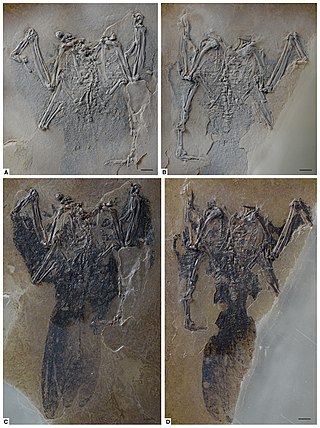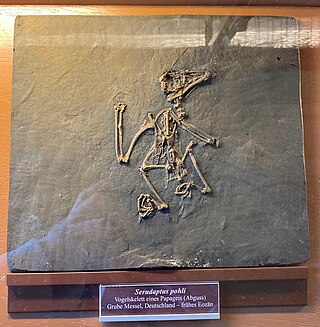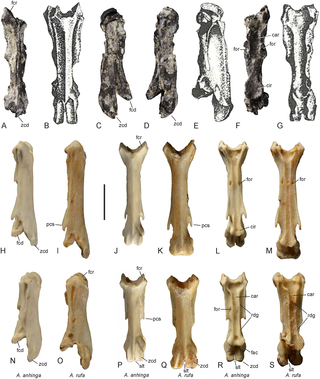Related Research Articles

The Messel pit is a disused quarry near the village of Messel about 35 km (22 mi) southeast of Frankfurt am Main, Germany. Bituminous shale was mined there. Because of its abundance of well-preserved fossils of the Messel Formation dating from the middle of the Eocene, it has significant geological and scientific importance. Over 1000 species of plants and animals have been found at the site. After almost becoming a landfill, strong local resistance eventually stopped these plans and the Messel pit was declared a UNESCO World Heritage Site on 9 December 1995. Significant scientific discoveries about the early evolution of mammals and birds are still being made at the Messel pit, and the site has increasingly become a tourist site as well.

The Naturmuseum Senckenberg (SMF) is a museum of natural history, located in Frankfurt am Main. It is the second-largest of its kind in Germany. In 2010, almost 517,000 people visited the museum, which is owned by the Senckenberg Nature Research Society. Senckenberg's slogan is "world of biodiversity". As of 2019, the museum exhibits 18 reconstructed dinosaurs.

Archaeotrogonidae is a prehistoric bird family known from the Eocene and Oligocene of Europe. They are members of Strisores, and are thought to be closely related to nightjars.

Dasornis is a genus of prehistoric pseudotooth birds. These were probably close relatives of either pelicans and storks or waterfowl; they are placed in the order Odontopterygiformes to account for this uncertainty.
Eurofluvioviridavis is a genus of extinct primitive birds from the Middle Eocene Messel Pit, Germany. It contains a single species, Eurofluvioviridavis robustipes. It is related to Avolatavis and Vastanavis, other members of the family Vastanavidae.
Eostrix is a genus of extinct primitive owls in the family Protostrigidae, along with Oligostrix and Minerva. These owls date from the early Eocene of the United States, Europe, and Mongolia. They have been described based on fossil remains. The genus was created by Pierce Brodkorb in 1971 to place a fossil species known until that time as Protostrix mimica.

Messelornis, also known as the Messel rail, is an extinct genus of gruiform bird, closely related to modern rails. It is the most abundant bird from the Messel Lagerstätte, representing roughly half of all Messel bird fossils with more than 500 specimens known. The fossil record are from the Paleocene to the early Eocene.
Qinornis is a prehistoric bird genus from the early-mid-Paleocene epoch, about 61 million years ago. It is known from a single fossil specimen consisting of a partial hind limb and foot, which was found in Fangou Formation deposits in Luonan County, China.
Australornis is a genus of extinct seabird discovered in New Zealand. It lived in the Paleocene epoch, 60.5 to 61.6 million years ago (Ma). The type species name originates from australis, Latin for "southern", and ornis, the Greek word for "bird", and lovei commemorates Leigh Love, an amateur paleontologist who discovered it.
Pumiliornis tessellatus is an ancient bird from the Middle Eocene of Messel, Hesse, Germany. It is described as a wren-sized anisodactyl bird with a long, slender bill and strong hallux. Its species name tessellatus, meaning "mosaic" in Latin, is a reference to its unusual distribution of characters and uncertain phylogenetic placement. It has some anatomical affinities with Cuculiformes, but similar fossils that might be related to this taxon do not.

Gruimorphae is a clade of birds that contains the orders Charadriiformes and Gruiformes identified by molecular analysis. This grouping has had historical support, as various charadriiform families such as the families Pedionomidae and Turnicidae were classified as gruiforms. It may also have support from the fossil record since the discovery of Nahmavis from the Early Eocene of North America.

Halcyornithidae is an extinct family of telluravian birds thought to be related to the Psittaciformes (parrots), Passeriformes (songbirds), and to the extinct Messelasturidae. Halcyornithids have been found in various Eocene formations in Europe and North America. Widespread and diverse in the Early Eocene of North America and Europe, halcyornithids are not found in locales later than the Middle Eocene. Halcyornithids were small, arboreal birds with zygodactyl feet, with two toes facing forwards and two facing back, a trait shared with other tree-dwelling families of Eocene birds like the Zygodactylidae and the messelasturids. The skull of halcyornithids features a ridge of bone above the eye called the supraorbital process, similar to birds of prey. The relationships of the halcyornithids to other birds remain uncertain. Halcyornithids have been proposed as relatives to owls and as a lineage closer to parrots than to songbirds. Most recently, halcyornithids have been identified as the sister group of the clade including parrots and songbirds. It is also possible that Halcyornithidae is paraphyletic with respect to the Messelasturidae.
Danuvius guggenmosi was an extinct species of great ape that lived 11.6 million years ago during the Middle–Late Miocene in southern Germany. It is the sole member of the genus Danuvius. The area at this time was probably a woodland with a seasonal climate. A male specimen was estimated to have weighed about 31 kg (68 lb), and two females 17 and 19 kg. Both genus and species were described in November 2019.
Madelaine Böhme is a German palaeontologist and professor of palaeoclimatology at the University of Tübingen.

Eocoracias is an extinct genus of bird related to modern rollers and other Coraciiformes such as kingfishers, bee-eaters, motmots, and todies. It contains one species, Eocoracias brachyptera, and it lived approximately 47 million years ago based on dating of the fossil site. It is known for a specimen having preserved non-iridescent structural coloration on its feathers, previously unknown in fossil birds. Fossils have been found at the Messel Pit in Germany.

Messelornithidae is an extinct clade of gruiform birds, closely related to modern rails. The fossil record are from the Paleocene to the early Oligocene of Europe and North America.

Allgoviachen is an extinct genus of anatid bird from the Late Miocene (Tortonian) Hammerschmiede clay pits of Bavaria, Germany. The genus contains a single species, A. tortonica, known from bones belonging to the left leg.

Anhinga pannonica is an extinct species of darter from the Miocene of Europe and Africa. Described in 1916, A. pannonica is the only species of darter to have existed in Europe and is notably larger than most extant species, with an estimated weight of 3.3 kg (7.3 lb). The species likely went extinct as the climate continued to cool towards the end of the Miocene and beginning Pliocene, heavily effecting the darter that would have required a subtropical or tropical climate to survive.
This is an overview of the paleofauna of the Eocene Messel Formation as explored by the Messel Pit excavations in Germany. A former quarry and now UNESCO World Heritage Site, the Messel Formation preserves what once were a series of anoxic lakes surrounded by a sub-tropical rainforest during the Middle Eocene, approximately 47 Ma.

The Hammerschmiede clay pit is a fossil bearing locality in Pforzen, Bavaria, Germany most well known for the discovery of Danuvius guggenmosi, the potentially earliest known bipedal ape. With an age of 11.66-11.42 Ma the site dates to the transition between the Middle and Late Miocene epoch, providing an important window into the faunal changes taking place during this time. This correlates to the time just after the Serravallian-Tortonian boundary, and the MN zones 7/8. It is one of the most well-known Miocene sites, with over 15,000 individual fossils and 117 species having been discovered as of 2020. It has been called "the most important German paleontological discovery of the last decades".
References
- ↑ Mayr, Gerald (2016). Avian evolution: the fossil record of birds and its paleobiological significance. Topics in Paleobiology. Wiley-Blackwell. p. 306. ISBN 978-1-119-02076-9.
- ↑ "Dr Gerald Mayr". Senckenberg – World of Diversity. Senckenberg Research Institute. Retrieved 2023-03-06.
- ↑ Mayr, Gerald (2009). Paleogene Fossil Birds. Berlin: Springer-Verlag. ISBN 978-3-540-89627-2.
- ↑ Mayr, Gerald; Lechner, Thomas; Böhme, Madelaine (2022-03-07). "Nearly complete leg of an unusual, shelduck-sized anseriform bird from the earliest late Miocene hominid locality Hammerschmiede (Germany)". Historical Biology. 35 (4): 465–474. doi: 10.1080/08912963.2022.2045285 . ISSN 0891-2963. S2CID 247310405.